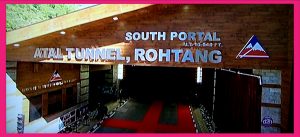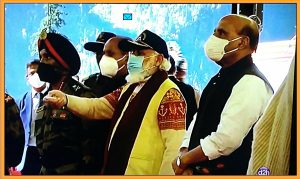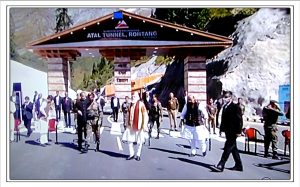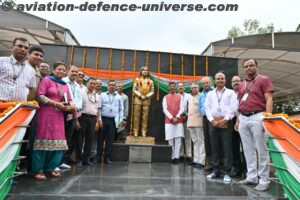
New Delhi. 03 October 2020. This is a landmark both for India’s strategic and developmental story. Atal Tunnel, Rohtang (previously known as Rohtang Tunnel), world’s longest tunnel above 10,000 feet, named after former Indian Prime Minister Atal Bihari Vajpayee,was inaugurated by Prime Minister Narendra Modi today.
It is a highway tunnel built under the Rohtang Pass in the eastern Pir Panjal range of the Himalayas on the Leh-Manali Highway. At 9.02 km (5.6 mi) length, the tunnel will be one of the longest road tunnels in India and is expected to reduce the distance between Manali and Leh by 46 km (28.6 mi). The tunnel is at an elevation of 3,100 metres (10,171 ft) whereas the Rohtang Pass is at an elevation of 3,978 metres (13,051 ft).
The Leh–Manali Highway, one of the two routes to Ladakh, The Rohtang Pass receives heavy snowfall and blizzards during winter months and is open for road traffic for only four months in a year. The tunnel will keep the highway open during the winter. The other route to Leh is through the Zoji La on the Srinagar-Drass-Kargil-Leh highway, which also gets blocked by snow for nearly four months in a year. Construction of a 14 km long tunnel under Zoji La has been planned. These two routes are vital to feed military supplies into military sub-sector in the west facing Aksai Chin and the Siachen Glacier.
The Atal Tunnel is not exactly under Rohtang pass; it is slightly west of the pass. The south entrance is north of Dhundi on the other side of the Beas River. The northern end of the tunnel meets the existing Leh–Manali Highway near Teling village, west of Gramphu, which is the first village after Rohtang Pass on the existing highway.
A 2.25 m high and 3.6 m wide emergency tunnel has been integrated in the tunnel cross-section beneath the main carriageway for evacuation during emergencies. The latest Austrian tunnelling method and ventilation system – semi transverse type considered as safest – has been adopted for this project. Heavy snowfall in the Rohtang Pass area is a major concern, especially on the approach roads to the main tunnel. To prevent any damage to the roads and to ensure the safety of the roads and tunnel users alike, avalanche control structures have been constructed. The design for these structures has being provided by the Snow and Avalanche Study Establishment of DRDO.
As the tunnel will witness heavy traffic, vehicular management and checking pollution is a priority. For this, CCTV cameras are placed at a regular distance and are connected to two monitoring rooms on both ends of the tunnel. Sensors to check the pollution level will keep on updating the data and if the record is above the desired level, then quantity of fresh air injected inside the tunnel would be increased. Pollution level will be controlled within 90 seconds adding that two heavy duty fans each on both openings of the tunnel will be installed to inject fresh air inside.

The tunnel has semi-transverse ventilation system, where large fans would separately circulate air throughout the tunnel length. Another safety feature added is that fire inside the tunnel will be controlled within an area of 200 metres and fire hydrants are provided on specific locations. The tunnel also has public announcement system to make important announcement in emergency situations for which loudspeakers are installed at regular distances.
The 117 km distance from Manali to Keylong on the other side of Rohtang Pass is usually covered by vehicles in about five to six hours, without counting the long hours of traffic jams on the hilly route. The same distance would now be covered in less than half-an-hour through the tunnel and without traffic snarls. Keylong would be just 40 km from North Portal and 49 km from the South Portal of the tunnel.
The most challenging task was to continue the excavation during heavy snowfall in winter. Excavation for tunnelling was done from both ends. However, as Rohtang pass closes during the winter, the north portal was not accessible during winter and the excavation was being done only from the south portal in winters. Only about one-fourth of the entire tunnel was excavated from the north end and three-fourths was excavated from the south end. There were more than 46 avalanche sites on approaches to the tunnel.

Other challenges to the progress of the tunnel included difficulties in disposing more than 800,000 m³ of excavated rock and soil, heavy ingress of water (as much as 3 million litres per day in June 2012) that required constant dewatering, costlier treatment and slowed the progress of excavation from 5-metre per day to just half a metre a day and unstable rocks that slowed blasting and digging. A cloud-burst and flash flood on 8 August 2003 killed 42 labourers who were building the temporary access road. Questions were also raised on the impact of cutting down more than 700 trees on the ecology.


























































































































